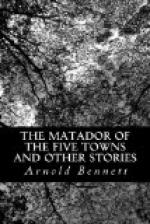And the deflation was not the sole cause of his gloom. There was another. He was on his honeymoon. Understand me—not a honeymoon of romance, but a real honeymoon. Who that has ever been on a real honeymoon can look back upon the adventure and faithfully say that it was an unmixed ecstasy of joy? A honeymoon is in its nature and consequences so solemn, so dangerous, and so pitted with startling surprises, that the most irresponsible bridegroom, the most light-hearted, the least in love, must have moments of grave anxiety. And Edward Coe was far from irresponsible. Nor was he only a little in love. Moreover, the circumstances of his marriage were peculiar, and he had married a dark, brooding, passionate girl.
Mrs Coe was the younger of two sisters named Olive Wardle, well known in the most desirable circles in the Five Towns. I mean those circles where intellectual and artistic tastes are united with sound incomes and excellent food delicately served. It will certainly be asked why two sisters should be named Olive. The answer is that though Olive One and Olive Two were treated as sisters, and even treated themselves as sisters, they were not sisters. They were not even half-sisters. They had first met at the age of nine. The father of Olive One, a widower, had married the mother of Olive Two, a widow. Olive One was the elder by a few months. Olive Two gradually allowed herself to be called Wardle because it saved trouble. They got on with one another very well indeed, especially after the death of both parents, when they became joint mistresses, each with a separate income, of a nice house at Sneyd, the fashionable residential village on the rim of the Five Towns. Like all persons who live long together, they grew in many respects alike. Both were dark, brooding and passionate, and to this deep similarity a superficial similarity of habits and demeanour was added. Only, whereas Olive One was rather more inclined to be the woman of the world, Olive Two was rather more inclined to study and was particularly interested in the theory of music.
They were sought after, naturally. And yet they had reached the age of twenty-five before the world perceived that either of them was not sought after in vain. The fact, obvious enough, that Pierre Emile Vaillac had become an object of profound human interest to Olive One—this fact excited the world, and the world would have been still more excited had it been aware of another fact that was not at all obvious: namely, that Pierre Emile Vaillac was the cause of a secret and terrible breach between the two sisters. Vaillac, a widower with two young children, Mimi and Jean, was a Frenchman, and a great authority on the decoration of egg-shell china, who had settled in the Five Towns as expert partner in one of the classic china firms at Longshaw. He was undoubtedly a very attractive man.
Olive One, when the relations between herself and Vaillac were developing into something unmistakable, had suddenly, and without warning, accused Olive Two of poaching. It was a frightful accusation, and a frightful scene followed it, one of those scenes that are seldom forgiven and never forgotten. It altered their lives; but as they were women of considerable common sense and of good breeding, each did her best to behave afterwards as though nothing had happened.




